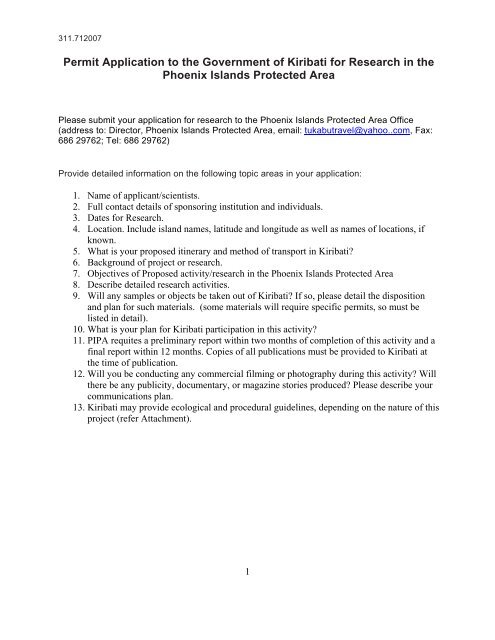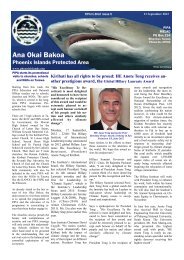Research Permit Application to the Government of Kiribati for ...
Research Permit Application to the Government of Kiribati for ...
Research Permit Application to the Government of Kiribati for ...
Create successful ePaper yourself
Turn your PDF publications into a flip-book with our unique Google optimized e-Paper software.
311.712007<br />
<strong>Permit</strong> <strong>Application</strong> <strong>to</strong> <strong>the</strong> <strong>Government</strong> <strong>of</strong> <strong>Kiribati</strong> <strong>for</strong> <strong>Research</strong> in <strong>the</strong><br />
Phoenix Islands Protected Area<br />
Please submit your application <strong>for</strong> research <strong>to</strong> <strong>the</strong> Phoenix Islands Protected Area Office<br />
(address <strong>to</strong>: Direc<strong>to</strong>r, Phoenix Islands Protected Area, email: tukabutravel@yahoo..com, Fax:<br />
686 29762; Tel: 686 29762)<br />
Provide detailed in<strong>for</strong>mation on <strong>the</strong> following <strong>to</strong>pic areas in your application:<br />
1. Name <strong>of</strong> applicant/scientists.<br />
2. Full contact details <strong>of</strong> sponsoring institution and individuals.<br />
3. Dates <strong>for</strong> <strong>Research</strong>.<br />
4. Location. Include island names, latitude and longitude as well as names <strong>of</strong> locations, if<br />
known.<br />
5. What is your proposed itinerary and method <strong>of</strong> transport in <strong>Kiribati</strong>?<br />
6. Background <strong>of</strong> project or research.<br />
7. Objectives <strong>of</strong> Proposed activity/research in <strong>the</strong> Phoenix Islands Protected Area<br />
8. Describe detailed research activities.<br />
9. Will any samples or objects be taken out <strong>of</strong> <strong>Kiribati</strong>? If so, please detail <strong>the</strong> disposition<br />
and plan <strong>for</strong> such materials. (some materials will require specific permits, so must be<br />
listed in detail).<br />
10. What is your plan <strong>for</strong> <strong>Kiribati</strong> participation in this activity?<br />
11. PIPA requites a preliminary report within two months <strong>of</strong> completion <strong>of</strong> this activity and a<br />
final report within 12 months. Copies <strong>of</strong> all publications must be provided <strong>to</strong> <strong>Kiribati</strong> at<br />
<strong>the</strong> time <strong>of</strong> publication.<br />
12. Will you be conducting any commercial filming or pho<strong>to</strong>graphy during this activity? Will<br />
<strong>the</strong>re be any publicity, documentary, or magazine s<strong>to</strong>ries produced? Please describe your<br />
communications plan.<br />
13. <strong>Kiribati</strong> may provide ecological and procedural guidelines, depending on <strong>the</strong> nature <strong>of</strong> this<br />
project (refer Attachment).<br />
1
311.712007<br />
ATTACHMENT:<br />
BIOSECURITY PROTOCOLS FOR ENTERING PHOENIX ISLANDS<br />
PROTECTED AREA (PIPA)<br />
Key risks <strong>of</strong> landing on <strong>the</strong> Phoenix Islands are that invasive alien species (IAS) may get ashore and<br />
subsequently have devastating impacts on <strong>the</strong> indigenous biota. Key IAS threats associated with landing<br />
are:<br />
• Rodents (rats/mice)<br />
• Foreign ants (e.g. species <strong>of</strong> fire ants or crazy ants)<br />
• O<strong>the</strong>r invertebrates, e.g. spiders, snails<br />
• Seeds <strong>of</strong> invasive weeds, e.g. lantana<br />
• Disease.<br />
These risks are significant and currently <strong>the</strong>re are no pest-pro<strong>of</strong> inspection facilities at most Pacific<br />
departure points and none at landing points in <strong>the</strong> PIPA.<br />
Pro<strong>to</strong>cols <strong>to</strong> minimise <strong>the</strong>se risks are as follows:<br />
Country <strong>of</strong> departure<br />
1. Observe cus<strong>to</strong>ms and quarantine requirements <strong>of</strong> departure country (e.g. Fiji, Samoa, USA) and<br />
destination country (<strong>Kiribati</strong>).<br />
2. Carefully inspect <strong>the</strong> wharf at <strong>the</strong> departure port <strong>to</strong> ensure that it has no infestations <strong>of</strong> ants.<br />
3. If dinghies or o<strong>the</strong>r small craft are <strong>to</strong> be used <strong>for</strong> loading, ensure that <strong>the</strong>se are free <strong>of</strong> ants and<br />
o<strong>the</strong>r invertebrates; always spray <strong>the</strong>ir interior with Permethrin-based insect spray. (Note: use<br />
Permethrin-based sprays only as <strong>the</strong>y have a residual effect - do not use<br />
Pyrethroid/pyrethrum sprays which are temporary knock-down sprays only).<br />
4. Obtain food s<strong>to</strong>res and o<strong>the</strong>r supplies from reputable and hygienic sources that minimise <strong>the</strong><br />
chances <strong>of</strong> rodents, ants, o<strong>the</strong>r invertebrates, weeds, etc, being present.<br />
On board <strong>the</strong> vessel<br />
5. Keep food s<strong>to</strong>res in sealed containers on <strong>the</strong> vessel.<br />
6. Maintain permanent rodent traps and/or poison bait stations (with diphacinone or brodifacoum<br />
baits) on <strong>the</strong> vessel.<br />
7. In <strong>the</strong> event <strong>of</strong> rodents or invasive ants being detected on board, fur<strong>the</strong>r quarantine advice is<br />
required from <strong>the</strong> PIPA administration.<br />
8. In <strong>the</strong> event <strong>of</strong> aerial insects being detected on board (e.g. wasps), quickly eliminate <strong>the</strong>se and<br />
inspect <strong>to</strong> ensure eggs have not been laid on board, e.g. on fruit.<br />
2
311.712007<br />
9. Avoid transporting live animals (e.g. pets, birds) on board unless <strong>the</strong>se are authorised by <strong>the</strong> PIPA<br />
and <strong>Government</strong> <strong>of</strong> <strong>Kiribati</strong>.<br />
Be<strong>for</strong>e landing at <strong>the</strong> Phoenix Islands<br />
10. At <strong>the</strong> destination island(s) keep all food and equipment being taken ashore <strong>to</strong> a minimum.<br />
11. Thoroughly inspect all food supplies, camping equipment and clothing etc as a first step be<strong>for</strong>e<br />
being transported ashore:<br />
The inspection must comprise a visual search <strong>for</strong> rodents, ants, o<strong>the</strong>r invertebrates and<br />
seeds.<br />
Carry this out in a clean, open, well-lit area, e.g. <strong>the</strong> deck <strong>of</strong> <strong>the</strong> vessel.<br />
Bang and shake items and develop a search image <strong>for</strong> ants which are <strong>the</strong> smallest and least<br />
conspicuous invertebrate likely <strong>to</strong> emerge.<br />
Wash or wipe any loose food items, e.g. fruit and vegetables, and place in clean insectfree<br />
bags.<br />
Keep a can <strong>of</strong> fly-spray handy at all times <strong>for</strong> rapid responses <strong>to</strong> emerging insects.<br />
Likely sites <strong>for</strong> seeds are in socks, shoes, Velcro, pockets, seams, etc. S<strong>to</strong>re any seeds<br />
found and destroy on return from <strong>the</strong> islands.<br />
12. After inspection in 11 above, all food, camping equipment and clothing must be placed in sealed<br />
containers (e.g. water-pro<strong>of</strong> drums) following <strong>the</strong> visual inspection above. The interior <strong>of</strong> <strong>the</strong><br />
containers must be sprayed with Permethrin insecticide at least one hour be<strong>for</strong>e leaving <strong>the</strong><br />
vessel and <strong>the</strong> container kept sealed during this period including <strong>the</strong> landing process. (Note that<br />
<strong>for</strong> health reasons it is advisable <strong>to</strong> wash any loose food items that were exposed <strong>to</strong> insecticide, but<br />
do this once ashore).<br />
13. At least one hour be<strong>for</strong>e landing, carefully inspect and spray (with Permethrin) <strong>the</strong> interior <strong>of</strong> all<br />
landing vessels that are being used <strong>for</strong> transporting people and supplies, etc, <strong>to</strong> <strong>the</strong> island(s).<br />
Whilst at <strong>the</strong> Phoenix Islands<br />
14. Kindly report <strong>to</strong> PIPA Office on any illegal activities at sea, land or elsewhere at <strong>the</strong> Phoenix<br />
Islands Protected Area<br />
After <strong>the</strong> expedition<br />
15. Provide a full report <strong>to</strong> <strong>the</strong> PIPA on <strong>the</strong> procedures above, including details <strong>of</strong> any IAS found,<br />
actions taken and <strong>the</strong>ir outcome(s).<br />
3





